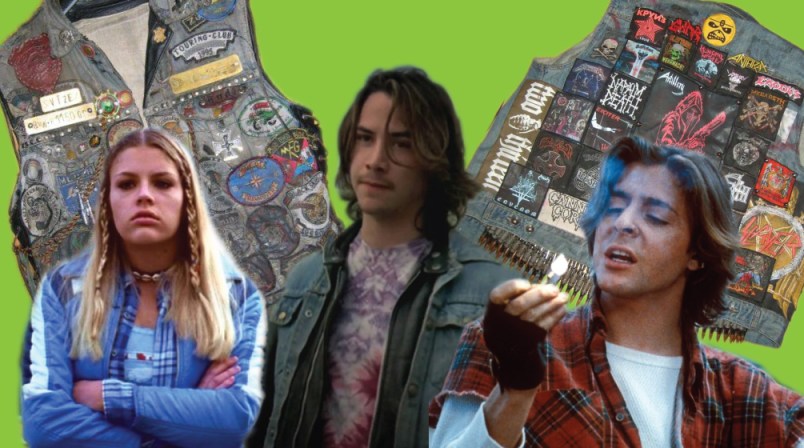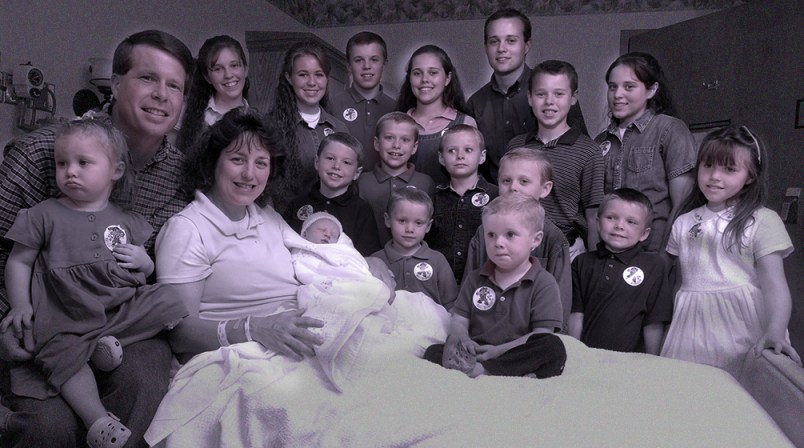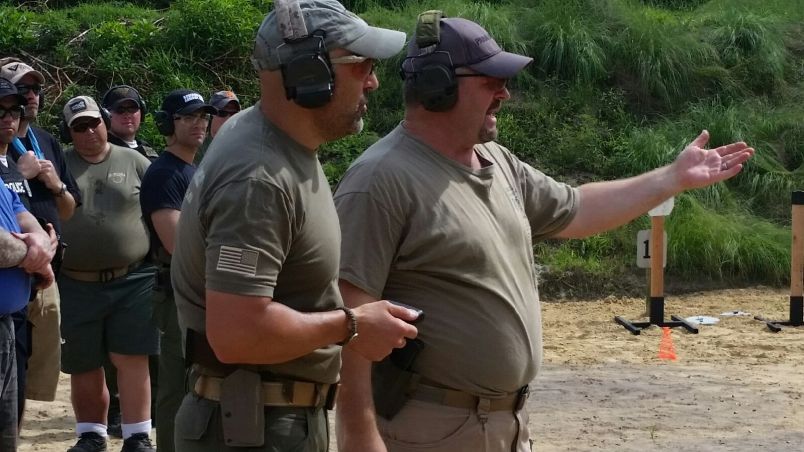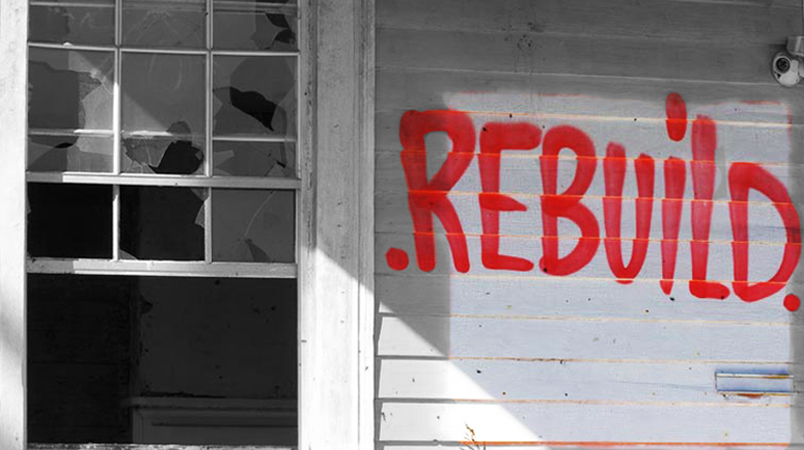In 1988, Reis O’Brien would never have admitted to his friends that his mom sewed the metal-band patches onto his denim vest. Once it got a baseline of patches—the massive one of the album cover for Ozzy’s “Ultimate Sin” was his favorite—he filled it in with others from metal bands like Slayer, AC/DC, Motorhead and Metallica.
There were rules to the jacket: You don’t ever let anyone wear it—“It wasn’t a stupid letterman’s jacket.” You never take it off—you wore it in school, in the house, over your Slayer t-shirt. You never washed it—too many spikes and studs would have damaged his mom’s dryer. Plus, it would have washed out the fake blood stains splattered on at a Gwar show.
“My vest was my daily coat of armor,” O’Brien says. “I often thought of it like a muzzle on a dangerous dog…it let people know that they probably shouldn’t get too close.”
“Burnout” wasn’t the kind of designation you willingly chose. It was a name given to you typically by a jock, or a “richie in a pair of khaki shorts,” like the guy who first called the working class O’Brien a burnout. Like a lot of the other metal heads (or headbangers or freaks) in his predominantly wealthy high school in Greensboro, North Carolina, “burnout” was a label they inherited.
It’s a cruel tag for anyone—but especially for a kid. Burnout or disenfranchisement are terms for the weary, something that’s supposed to happen over time. How do you regard a teenager as burnt out from society?
“Burnouts were like dropouts,” a friend of mine, who identified as a punk in high school, told me. “They weren’t into causes or angry at the world, it was more a ‘fuck you’ and ‘who gives a shit’ attitude.”
If I asked you what “burnout” meant today, you might conflate it with all kinds of other labels: stoners, skaters, slackers, punks. But the “burnout”—or “burner” for short—could have only existed in an era where extreme excess and poverty converged. And because our country has since shifted hugely in both economic and cultural ways, this kind of teenager can probably never exist again.
It was the 1980s, and Wall Street was a shining beacon. Country clubs, with their supple, grassy expanses, were like Mecca for the rich and weary. The hippies were over fighting the Establishment; now it was time to cash in. In high school, jocks were the teenage counterpart to the male, white bankers, or as Tom Wolfe coined them, “Masters of the Universe.” They generally came from upper-middle class families, but their cash came in the form of school power. In movies of the era, they were depicted as blonde, over-entitled, bullying dickheads.
Burnouts, on the other hand, were unapologetically, in-your-face working class. The poster boy of the burnouts was Judd Nelson’s character, John Bender, from The Breakfast Club. Sporting long hair, baggy Dickies and a cut-up flannel shirt, he talked freely and angrily about his father, a drunk who burned his arm with a cigar because “This is what you get in my house when you spill paint in the garage.” Burnouts came from working class families and were enrolled in vocational classes. They defiantly smoked Marlboro Reds in public places like courtyards and parking lots. In my blue-collar hometown of Clifton, New Jersey, burnouts were sometimes associated with devil worshipping or teenage suicide pacts or animal sacrifices.
But mostly, they were kids pushed to the outskirts of life—they weren’t completely oppositional like the punks, they weren’t cutting-edge enough to be “alternative.” (In the ‘80s, that term was loose; you could catch proto-alternative bands like New Order, Joy Division, The Smiths and early R.E.M. on MTV’s Sunday night video show 120 Minutes.)
Burnouts symbolized the ‘80s cultural split between the adult middle class and the adult working class. Whereas black families endured decades of racist mortgage policies and were essentially kept out of the suburbs, these white working class kids lived on the burbs’ peripheries and were the underclass of their high schools. They were outliers in a pre-Occupy time when wealth was nothing to be ashamed of. As America morphed into the 1990s, so did burnouts. But then they virtually disappeared in the aughts. Why? What exactly extinguished the burnouts?

We’re poorer than the Socs and the middle class. I reckon we’re wilder, too…Greasers are almost like hoods; we steal things and drive old souped up cars and hold up gas stations and have a gang fight once in a while.” –S.E. Hinton, The Outsiders
Just like every other social group, burnouts have historical precedents. They took inspiration from the iconic greasers, characters like Pony Boy Curtis from S.E. Hinton’s The Outsiders, Danny Zuko and Rizzo from Grease, or Fonzie and Chachi from Happy Days, who were also raging against a moment of unusual affluence and conservatism. The greasers were the rebels with the leather jackets who didn’t listen to Mama and Daddy, the kinds of nonconformists who took risks.
In sociologist and reporter Donna Gaines’s book Teenage Wasteland, which centered around a suicide pact of four burnouts from Bergenfield, New Jersey in 1987, she explains that there have been suburban kids since the 1950s who wouldn’t cooperate. “In the social order of the American high school, teens are expected to do what they are told—make the grade, win the prize, play the game,” she writes. “Kids who refuse have always found something else to do. Sometimes it kills them. Sometimes it sets them free.”
Unlike the hippies of the 1960s and ‘70s, it wasn’t cool to be a rebel in the ‘80s. Greed was good. People were supposed to, in theory, have cleaned themselves up. They weren’t exactly straight—there was still a huge drug culture—but it centered on cocaine, that Bolivian marching powder, the drug that made you wake up and sit up straight.
“The ‘80s was a time of rising economics for a class of people,” Brandeis economics professor Kathryn Grady says. But “there was also a class of people who were very much left behind. You were either in that group or you weren’t. It seemed okay to go to Wall Street back then. And it’s not anymore. At least not in the same way.” Social classes were expressed through clothing, Grady tells me, “because what you could afford had to do with your social standing and going to the right stores. Having the right clothing was so important.”
The ‘80s has the rep of being a golden era, an economic boon for everyone. Yet a wide variety of economic research shows that during the mid-to late-‘80s, there was a great economic gap between the average middle class family and the lower-middle class family—those folks on the lower end were known by politicians across the country as the “new poor.” The loss of blue-collar jobs has a lot to do with this; blue-collar workers, who had higher-paying union jobs in the late ‘70s, lost their jobs in record amounts—2.4 million jobs were eliminated between 1979 and 1994. High school dropouts were also earning less money than they had 10 years earlier.
The poverty rate rose in dramatic numbers in the middle of the decade according to the National Poverty Center, so much that by 1983, the number of folks below the poverty line had risen to a little over 35 million people. By 1989, the poverty rate increased another 10 percent, according to the U.S. Census Bureau, and by the end of the ‘80s, the poorest families grew poorer in 32 states. Despite the millions of folks struggling to put food on the table, the middle class was still very comfortable. (That didn’t last long; by the end of the ‘80s and early ‘90s, the middle class was struggling too.)
The effects of this poverty was worsened by educational policy. If you were a jock, then at least you had somewhere to go once the bell rang, but afterschool programs were virtually non-existent then. (Not that they’re great now, or that they’re funded properly, but even their basic need was unfounded at that point.)
Nostalgic comedies like The Wedding Singer and Hot Tub Time Machine tend to depict the ‘80s as one big-haired teenage joke, rather than the deeply culture divide that developed in this decade. One exception is Paul Feig’s and Judd Apatow’s short-lived TV series, Freaks and Geeks, airing in the late nineties but set in a fictional suburb of Detroit between 1980 and 1981. Among other things, the show depicts the inner lives of the “freaks” in a way that acknowledges this suburban chasm.
In a famous episode, “Kim Kelly Is My Friend,” we get to know Kim, one of the show’s freaks. Among the things we learn: She drives a broken-down Gremlin, her aunt Kathy OD’d on cocaine, her house is in a state of half-constructed disarray, and her parents try to take her car away after calling her a loser. Like Bender’s casual admission of enduring child abuse, Kim’s family’s economic struggles were not only common in working class areas, they were out in the open, not only on the show, but also in communities across the country where more and more working families fell below the poverty line between 1979 and 1984.
You can watch “Kim Kelly Is My Friend” on Netflix now, but in 1999, NBC wouldn’t air it. It was just a little too bleak for mainstream families’ living rooms.
But Freaks and Geeks was an accurate picture of the hopelessness many teenagers felt in the 1980s. Teenage suicide, especially among white kids, tripled between 1950 and 1980 and then rose again in the mid-1980s. The states with the highest suicides in the ‘80s were predominantly rural. The four Bergenfield teenagers who committed suicide, which Gaines writes about in her book Teenage Wasteland, were called “troubled losers,” “druggies,” “dropouts” and, of course, “burnouts.” It was as if these suicides were no one’s loss.
“I redefine burnouts as wasted kids,” Gaines tells me. “They were wasted by society—they weren’t wasted by their drugs. They were wasted by being superfluous youth at a time when competitive capitalism was transforming into a global economy…They didn’t get the cultural, social economic support that they should have had.”

When I flip through my high school yearbook from 1989, I can spot the burnouts easily. I look for this one boy from my photography class, a loner with dark feathered hair, a Metallica t-shirt and a black leather motorcycle jacket. He never took that jacket off, and while the teacher lectured about aperture and F-stops, I always wondered, Where is he going?
The burnout’s jacket, Stanford sociology professor Penelope Eckert wrote in her book, Jocks and Burnouts, was more than a weighty symbol; it was an ideology. Eckert studied teenagers from 1980 through 1984 in high schools around suburban Detroit. She found that early on, the burnouts were groomed to be outsiders—away from teachers, authoritarians, adults in general. The jacket was a way to embrace that.
“The burnouts signal their peripheral relation to the school—the fact they are ‘just passing through’—by wearing their jackets all day in school,” she wrote.
Every burner from pop culture has that jacket. The iconic one belonged to Keanu Reeves’ character, Matt, from River’s Edge. His was a black leather biker, long-sleeved with a jean cut-off vest layered over it. He had long, greasy hair and a tie-dyed t-shirt. Keanu’s character was a hopeful, sensitive guy—his mother was a struggling waitress, a stoner, who could barely keep track of her three kids. Matt was always in the back seat of someone’s car, or being dragged into the police station or worried about his little sister and her doll. Matt was lonely, always trying to hold on to something. Or maybe he was just trying to let go.

It wasn’t that the burnouts ceased to exist, it’s that they shifted” in the 1990s, cultural critic Maura Johnston tells me. The turning point for how this culture changed, she says, was the movie Clerks. Kevin Smith’s first movie is a ‘90s classic, a post-burnout “slacker” film with a soundtrack full of Soul Asylum and Alice in Chains. But Johnston tells me to imagine Clerks if it were made five years earlier: “Dante and Randall [the two main characters] would have had longer hair and they would have been listening to Megadeth.”
What’s the difference between a slacker and a burnout, other than their respective decades? Back in the eighties, being a burnout wasn’t mainstream. The slackers of the ‘90s were defined by broader Gen X qualities like apathy, disillusionment, irony and disengagement. Slackers also weren’t generally teenagers; they were college kids or high school graduates who were all of a sudden being told that they wouldn’t do as well as their parents. That wasn’t something anyone had heard before. Unless you were a burnout, of course.
To understand the mainstream transition from burnout to slacker, consider some of the lines from Richard Linklater’s iconic Slacker in 1991:
Woman: Did you vote in the most recent election?
Hitchhiker: Hell no… I’ve got less important things to do.
Girl on street: What are you up to?
Guy: Same old, same old. Just lollygagging around… still unemployed. I’m in this band. Well, the one I was in before, but we changed our name. We’re “The Ultimate Losers” now.
In the 1980s, any of those people would have been vilified as shiftless dropouts. But by the mid-nineties, Beck was a “loser,” Thom Yorke “wished he was special” and Kurt Cobain admitted “I’m not like them, but I can pretend.” Suddenly, mercifully, it wasn’t cool to be rich and clean and cocky anymore. Nobody wanted to be Ben Stiller in his perfect suit with his perfect hair rolling his eyes at Ethan Hawke’s winter of discontent.

If you look at the ‘80s as the era of excess, it’s easy to see how the burnouts could have been left behind. In towns like Clifton or Bergenfield, or in the suburbs of Detroit where factories were closed and working class families were pushed out, sports became key to survival. They were, and still are, a constant. In a town like Bergenfield, as Gaines wrote, the test scores weren’t so great—athletes propped up the schools and, in turn, the property taxes. In the 1980s, the jocks were the kids who reflected middle class “family values.”
The burnouts weren’t just a subculture, they were a threat. If your kid burns out, our town will burn out. Our future will burn out.
Nowadays, class lines are much blurrier, and it’s reflected in our clothes. There’s a relative coolness in the working class aesthetic. It’s why we see shredded metal t-shirts in Forever 21. It’s why, while shopping in Bloomingdales the other day, I saw an $80 t-shirt with a collar so frayed that the fabric was literally hanging by a few threads. That look isn’t just ironic—it’s an infusion of class in fashion. Rich, young urbanites have been romanticizing the poor since they came on the scene in the early aughts.
Thirty years ago, things were more black and white, sartorially and otherwise. “There was no room for experimentation or artsy-ness,” Gaines says of the 1980s. “You were either good or you were bad.” The decade’s “good kids” were wearing frilly dresses and cotillions or khaki shorts like the “richie” who first called Reis O’Brien a burnout. Today’s clothes are much cheaper than they were in the ‘80s and sometimes it’s hard to know the economic background of teenagers based on what they’re wearing.
And even if young people can afford a certain look, they want to appear as if they can’t. Because in post-recession 2015, being wealthy makes you an outsider. It’s why hipsters are known for their ramshackle apartments in expensive city neighborhoods and their $5000 bikes, not their fancy cars. It’s why normcore became the anti-fashion fashion last year, and why Mark Zuckerberg still wears a ratty hoodie. Our current economic climate couldn’t give rise to the burnout now, because the burnout is no longer the “other.” The only “other” is the one percent.
Statistically, we’re far more tolerant now. “Whatever [the burnouts] went through was an artifact of the high school being really intolerant and uptight,” says Gaines, “with really nasty people who were judgmental and boring and who had no clue. The kids survived it in spite of this.”
Reis O’Brien, the heavy metal dude with the bloodstained jacket, is a poster child for this resilience. He’s now the lead designer for Funko, a pop culture toy company, and the creator of his own robotic-fusion-fantasy toy line called Bim Toy in the Seattle area. O’Brien’s avatar on his Pinterest profile is of one of Funko’s Pop dolls. It has a shaved head. White beard. Black t-shirt. Red suspenders. His tagline is a Scorpions lyric: “Here I am. Rocked you like a hurricane.”
Hayley Krischer is a freelance writer based in New Jersey. Her work has appeared in The Toast, The Hairpin, Salon, The New York Times and other publications. You can find her on Twitter.






